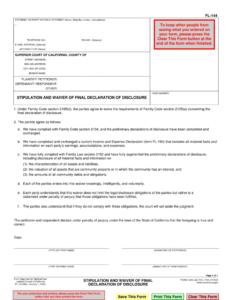
Family Law Forms, California
FL 144 – Stipulation and Waiver of Final Declaration of Disclosure
Tutorial:
I am Douglas Pinkham with Pinkham &Associates, APLC. We are a dedicated Family Law firm. We practice
exclusively in the area of California Divorce and Family Law. We can assist you no matter where you are located in the state of California. You can also watch our video tutorials discussing different forms and processes to help you through your divorce process.
This particular tutorial is going to concentrate on your Stipulation and Waiver of Final Declarations of Disclosure, form FL 144. Below is a screenshot of the form.
First, let us explain what the purpose of this form is. When you get divorced in California, the State requires both parties to disclose to the other everything each knows about both parties’ income, expenses, assets, and debts. Think of yourselves as two directors of a corporation that is dissolving, which is exactly the same as dissolving a marriage. You both have to disclose everything you know about all the finances to each other before the State will dissolve your marriage. In fact, you may find it interesting that there are several corporations codes that actually apply to divorce cases.
Much like every form, when you start filling out your FL 144, you need to put your information on the top. Add your Name, Address, and Telephone number. In the space marker, “Attorney For” you are going to put your name if you are filling the form out for yourself. Then add the County in which you are filing all your forms, and then the address of the court branch in which you are filing your forms. That court address is readily available on the internet. The (branch) name is the specific name of the branch of the court you are filing your paperwork. For example, the court in Downtown Los Angeles is the Central Branch; in Orange County, it is the Lamoreaux Justice Center. Again, this is also available on the internet. Most counties have only one location to file Family Law documents, other counties like San Diego or San Bernardino and certainly Los Angeles County have many different branches, so make sure you put the name of the correct branch.
Then you have the “Petitioner’s” name. The Petitioner is the same petitioner from the very beginning, the party who filed the petition for dissolution, and the respondent is the person who filed the response. These titles never change. Then, you are going to put the “Case number” to the right, and then all you need to do is put your name and date on the bottom left and sign to the right.
CAREFUL…Make sure you date the day you sign the form and keep in mind this form is actually a very, very big deal. What it says is under Family Code Section 2105(d), the parties agree to waive the requirements of the family law section 2105(a) (to waive your final declarations of disclosure). Let’s back up a tiny bit. After a divorce is filed, both parties are required to do these disclosures. Proof of service of your disclosures is supposed to be filed by the Petitioner 30 days after filing the petition and by the Respondent within 30 days of filing their response. Some people take longer, but you are supposed to do it within 30 days of filing your paperwork. Then, you are supposed to do your Final Declarations of Disclosure toward the end of your divorce case closer to the date of your trial.
The purpose of the Final Declarations of Disclosure are to update and augment the Preliminary Declaration of Disclosure with up-to-date information. For example you may have investments, and the investments values have changed. You may have had debts that had been paid off since the preliminary declarations were filled out, and obviously you have new bank statements each month that must be disclosed to the other party. All financials change as time passes throughout the process. But, if you are going through an agreed-upon divorce and your entire divorce only takes a couple of months to get completed and you are only waiting for the State of California to get through their six-month waiting period to give you your divorce, it’s almost a waste to do preliminary declaration of disclosure in, say, April and then follow it up in June by doing final declarations of disclosure when all the information is basically still the same. So, in situations like that, the State of California allows you to waive the final declarations of disclosure if you both agree to do so, and that is what this form is used for.
Again, keep in mind this is very, very important. You may not waive final declarations of disclosure unless you have already properly completed and served your preliminary declarations of disclosure. So, make absolutely certain that you do the preliminary declaration of disclosure properly before you try to waive final declarations of disclosure.
Keep in mind we also have a very detailed video explaining how to do your Preliminary Declarations of Disclosure step-by-step, form by form, line by line. Feel free to use that video to help you do your preliminary declarations of disclosure.
If you need additional help, give us a call. Again, my name is Douglas Pinkham with Pinkham & Associates. Our firm is in Southern California, but we may be able to assist you with parts of your divorce no matter where you are located in the state of California.




